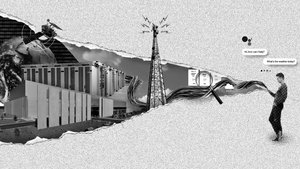Why digital does not equal green: A leaner, cleaner website for Pratt Center

At some point over the years, some smart member of our team affixed a sticker to the kitchen paper towel dispenser that said: “These are made from trees.” The point of this sticker was not to trigger immediate disavowal of all paper products forever but to call attention to the environmental impact of our daily decisions—with so many reusable options out there, why paper towels?—and nudge us to rethink what and how much we consume.
Creating a more sustainable urban environment has always been central to Pratt Center’s mission. But until we started to redesign our website, we had never considered the extent to which our digital behaviors harbored hidden environmental costs.
In 2017, Greenpeace reported that the energy footprint of the IT sector accounts for an estimated 7% of global electricity use. This energy use is increasing with the rapid adoption of online technologies, and may account for as much as 4.7% of global emissions, according to the Shift Project. Yet we often underestimate this footprint because the infrastructure that powers our devices—huge data storage centers spread all over the globe—is largely invisible.
Advocates have begun to ask how we might address this growing digital carbon footprint and what a move toward “digital sobriety” might look like. Web designers and developers have begun to propose practices and design solutions to cut down on the amount of data transfer required to browse a website.
“When we began conversations about a new website, this dimension didn’t enter into it at all,” said Nepal Asatthawasi, Pratt Center’s Director of Development and Operations. “But our design and development team at GrayBits knew sustainability was core to our identity, and they gave us the idea to integrate our mission and values into our design decisions.”
One of the ways this translates to our new website is through the use of economizing images, which are “the single largest contributors to page weight. The more images you use and the larger those image files, the more data needs to be transferred and the more energy is used.” [1]
On the new site images and photos will appear, by default, as lo-res (low resolution). The small split circle icon in the top-right corner of each image enables users to load the full-res version as well as revert back to lo-res.
Like the sticker in our kitchen, this is not meant to dissuade you from viewing the images, but to serve as a reminder that even in digital domains, there are real environmental impacts. The website carbon calculator estimates the new prattcenter.net is cleaner than 91% of other sites that have been tested. Think of this as the “battery-save mode” for browsing our website.
If viewing in lo-res mode is not for you, it can be bypassed by selecting “Load All Full-Res” in the footer of any page on the site.
Resources:
- Website Carbon Calculator
- Clicking Clean Report (Greenpeace)
- Lean ICT: Towards Digital Sobriety (The Shift Project)
- The push to ensure clean energy powers digitalization (RESET)
- Energy efficient website design (Method & Class)
- 17 ways to make your website more energy efficient (Whole Grain Digital)